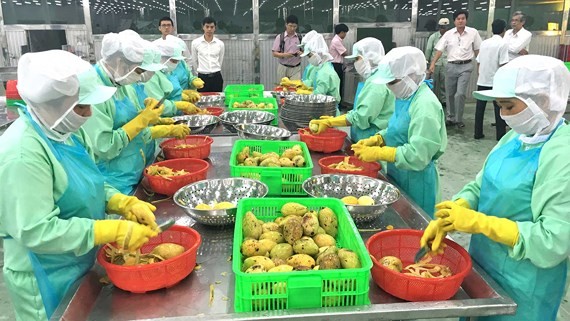
China is the main export market of Vietnam with proportion accounting for more than 70 percent last year. It is also the largest import market of Vietnamese rice, rubber, fruits and pangasius fish. However, most export activities earlier were unofficial cross-border trade which contains risks for Vietnamese traders. Farm produce exported via unofficial cross-border trade do not require tests for plant protection drug residues. In addition, there is no written contract between sellers and buyers for it to be legally binding so buyers will easily break the deal.
According to the Vietnam Trade Promotion Agency, Vietnam and China governments have come to an agreement that import and export management will gradually shift to export through official channel and reduce cross-border trade. Although higher quality of goods is required in exporting through official channel, many firms still want to officially export goods to China because of it stability and safety.
Mrs. Ngo Tuong Vy, deputy director of Chanh Thu Fruit Import and Export Limited Company, said that her company is waiting for legal and technical requirements from the negotiation between Vietnam and China to add durians to its list of exported fruits to China as her company already has stable durian growing area under VietGAP standards and a processing plant that meets export standards to the US.
Sharing the way to export goods to China, Mr. Pham Ngoc Thuc, director of Kim Chinh JSC, said that firms have to seek for trade partners via trade fairs and conferences and have support from the government when approaching regulations and legal framework relating to this activity. More importantly, firms have to understand regulations on exporting goods to China.
Chinese market expert Shi Xin Bao, director of Liaocheng Xinghao IM&Export Company, said that since the beginning of this year, China’s customs authority has conducted checks on phytosanitary certificate on plants imported from Vietnam, of which, it requires that the name and code of packing company must be specified. This packing company must register with Vietnamese authorities and receive recognition of China’s General Administration of Customs on its website. In order to avoid goods from being stagnant, Vietnamese firms should improve effectiveness of the certificate of origin, conduct digitalization of certificates and systemize the entire process for easier look-up when needed. Initially, firms should build laboratories for quick test on their products, gain trust of Chinese partners by supplying products of high quality steadily with flexible and safe payment methods. Especially, they need to invest in advanced technology to preserve farm products as well as modern management system.
Deputy minister of the Ministry of Agriculture and Rural Development Tran Thanh Nam said that Vietnamese firms should collaborate in production so as to be proactive in stable material supply, ensure suitable model and transport costs to increase competitiveness and take advantage of export forums of the two countries to meet their partners. The ministry will cooperate with its Chinese partner to train for firms about requirements in exporting and importing to provide favorable conditions for firms in clearance of goods from business and exchange method to money transfer.
Mr. Le Thanh Hoa, deputy head of the Agro Processing and Market Development Authority, said that firms should replace final product inspection by manufacturing process monitoring, build popularization and marketing strategies for their products, connect with Chinese partners to promote export and help Vietnamese products to enter deeply into China’s market and train technicians to control food safety in production and processing.
























